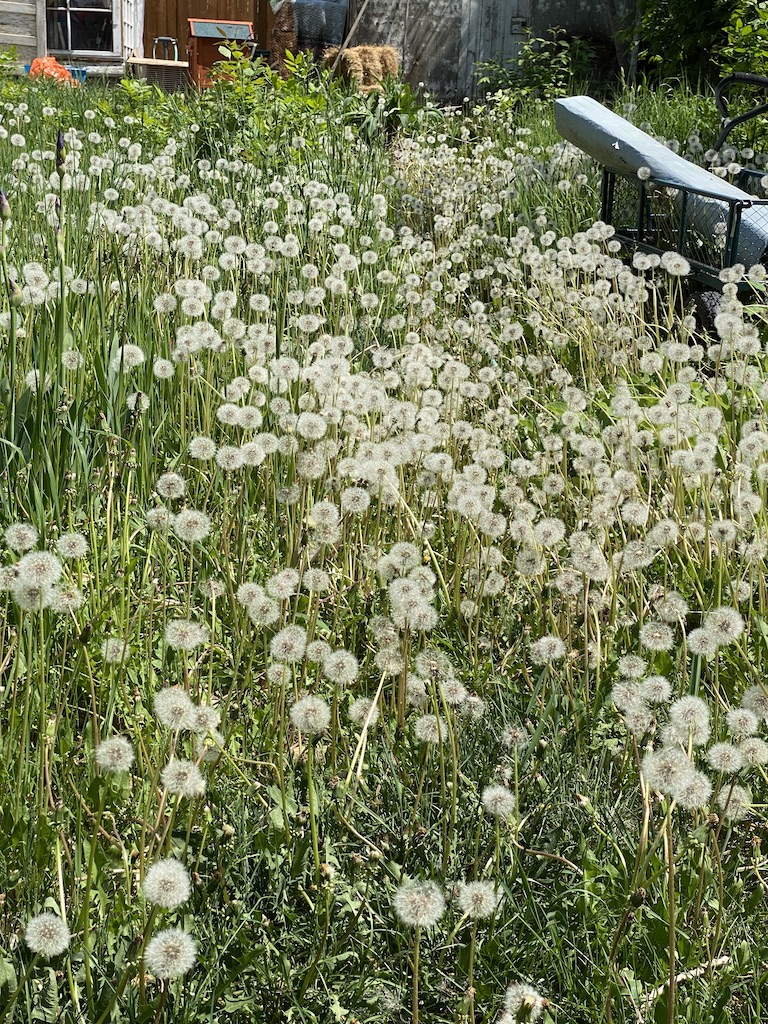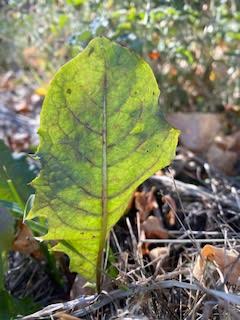Dandelion, Taraxacum officinale
Your yard is infested with dandelions.

This was my backyard. I harvested all the seed heads and placed them in a paper bag. Later, I made dandelion seed milk by blending a handful of seed heads in a blender full of water. I then strained the mixture through a clean cloth (I didn’t want any of the fuzzies). The result was a light beige color liquid that tasted slightly earthy.
Lucky you! 😀
You have a rich resource for food and natural remedies right outside your backdoor.
All parts of the dandelion can be used for remedies or food, providing they haven’t been sprayed with chemicals or have animal droppings nearby.
The leaves of the dandelion can be used in the way green leafy foods are generally consumed. In the spring, they are fresh and less bitter than when the plant forms a flower. But I have gathered large green leaves mid summer, that have been well watered and grown in shady areas of the yard and they are tasty as well. After gathering and washing the leaves, I have chopped them and added them to an omelette, used the chopped leaves in pesto, in lasagna, or steamed with other greens like spinach. I also gather and dry the leaves and save them in a paper bag along with other greens I gather from my yard for a fresh, local and free powdered greens mix to add to soups, teas, smoothies, sauces, etc, during the winter.
Why would a person want to eat dandelions?
Most folks know that dandelions have a bitter taste. Our tongues generally don’t favour the taste of bitter. However, that is the flavour that is lacking in our modern diet and it brings a host of health benefits.
Bitter flavours:
- Stimulate gastric juices in our stomach for better digestion of foods.
- Better mineral absorption from what we eat
- Improved fat emulsion
- Improved breakdown of proteins and carbohydrates for absorption along our digestive tract
- Bitters calm the nervous system. Bitter flavour tones the vagus nerve for the parasympathetic action of ‘rest and digest’.
The modern palette has been lied to. The processed foods we choose to eat sometimes contain artificial flavours and colors. These ingredients are included to mimic real flavours and colors of food, providing the illusion that we are eating nourishing foods.

Fresh, wild blueberries, picked in northwestern Ontario.
Ask yourself, does an artificial blueberry, with artificial flavour and color, actually taste like a fresh blueberry? It certainly lacks the nutritional components of a fresh blueberry. Instead of providing our body with usable and desirable ingredients, we give our body something fake. Our hard earned $$ and time goes toward foods with too much sugar, salt, chemicals and fillers such as cellulose, instead of giving our body readily accessible, fresh, free nutrients that grow all around us.
Bitter flavour is bitter for a reason. Some toxic plants are bitter to repel us, as well as animals and insects, from eating them. Our body benefits from non toxic bitter plants, in moderation.
In some areas, as soon as the snow melts dandelion hearts are gathered by local people. They can be a treat after a long winter of consuming heavy, fatty, preserved foods in our area of the globe. I have gathered them from my yard. The dandelion heart is the joint below the leaves and above the root (clean them thoroughly as they are right at the level of the soil). These can be added to a stir fry of vegetables, steamed and buttered or battered and fried.
When the dandelion blooms, the flowers can be gathered and made into jelly. They can be dried and added to herbal teas. The fresh yellow petals of the blossoms look pretty when added to a salad or a rice dish for color. Dandelion blossoms were used to color butter, back in the day when people gathered cream for their own butter.
The roots of the dandelion not only break up the soil from compaction, they taste delicious, roasted and made into a dark, earthy, warm or cool drink. The aroma of roasting roots is like chocolate chip cookies (perhaps we might add some cookies to the oven as well).
Watch the roots closely as they burn easily. The best time to gather the roots is in the fall, when the inulin (natural sugars) are highest.

Dandelion roots and leaves have been used for food and natural remedies. Our ancestors around the world would use them to assist in liver function. The liver produces bile which is then stored in the gall bladder. When fat is eaten the gall bladder releases the bile which emulsifies and digests fat and cholesterol. The liver also assists in managing glucose in the blood.
The benefits of adding dandelion to our diet is huge. There is a large assortment of information on the benefits of dandelion. Below is a summary of nutrients available from this abundant plant:
- Taraxacum officinale (Dandelion) contains a strong assortment of vitamins A, C, E, K, D and B
- Minerals of calcium, sodium, magnesium, iron, copper, silicon, zinc, manganese, potassium, phosphorus.
- Other constituents such as phenolic compounds have antioxidant effects, coumarins have anticancer, anti-inflammatory, antibacterial, and anti thrombotic effects.
- Inulin from the roots have a variety of actions in the body:
- prebiotic for microbiome health in the intestines
- blood sugar stabilization
- lowering of blood triglyceride levels
- benefits to the gut associated lymphoid tissue on immunity
- absorption of calcium and magnesium which may benefit bone formation
- beneficial effects on the lining of the bowels, decreasing inflammation.
- Flavonoids, like quercetin and sesquiterpene lactones, have a beneficial action on the immune system.
A person gets the sense that this single plant may have a positive effect on their body. We should consider, however, that there may be instances where a person should be cautious about their use of dandelion in their life. A person on diuretics or blood thinning medications should limit their use of dandelion as this is another action of dandelion in the body. Also, someone who has a dandelion allergy would not use this plant. Since it has blood sugar balancing actions, a person diagnosed with diabetes would be cautious and monitor their blood sugar levels closely.
If you would like support when using dandelion for your health, consider working with a qualified herbal practitioner. (03/25)
Resources:
https://pmc.ncbi.nlm.nib.gov/articles/PMC9002813/#B14-nutrients-14-01350
Herbal Constituents Foundations of Phytochemistry, 2nd editions, Lisa Ganora, pg 120-121
The Wild Wisdom of Weeds, Katrina Blair, pg 147-166
The information contained within this website is for information purposes only. This website is not a substitute for the advise of a health care professional nor should the information contained herein be used to diagnose, treat or prevent any disease or illness. Consult a healthcare professional for all your healthcare needs.